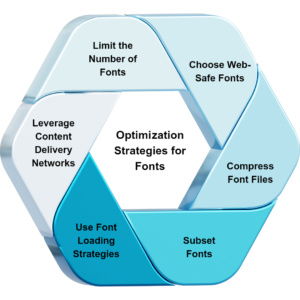Users expect instant access to information, So optimizing your website’s performance is crucial. One often overlooked aspect of website optimization is font usage. While fonts play a vital role in enhancing the overall aesthetics and branding of your website, improperly optimized fonts can significantly impact its load time. In this blog, we will explore effective strategies to optimize your website’s fonts for faster load time, ensuring a seamless user experience.
Understanding the Impact of Fonts on Load Time:
Fonts are an integral part of web design, but they can add considerable weight to your website’s resources, affecting its performance. Each font style and variation comes with its own set of files, including font files, CSS files, and other associated assets. When these files are not optimized, they can slow down the rendering and loading process, leading to frustrating delays for your visitors. By optimizing your website’s fonts, you can reduce the overall file size and minimize the number of HTTP requests required, resulting in faster load times.
Optimization Strategies for Fonts:

Limit the Number of Fonts:
Using a wide variety of fonts can significantly impact your website’s performance. Each additional font adds more files that need to be downloaded, resulting in slower load times. Therefore, it’s recommended to limit the number of fonts to optimize your website’s fonts. Choose fonts that align with your brand and design aesthetics while keeping the number to a minimum.
Choose Web-Safe Fonts:
Web-safe fonts are fonts that are pre-installed on most operating systems and web browsers. By utilizing web-safe fonts, you eliminate the need to download font files, reducing the overall load time. Popular web-safe font options include Arial, Times New Roman, Verdana, and Georgia. However, if you require a specific font that isn’t web-safe, proceed to the next optimization steps.
Compress Font Files:
Font files can be compressed to reduce their file size without compromising quality. Tools like Font Squirrel or Transfonter allow you to upload your font files and generate compressed versions for web use. Compressed font files can significantly reduce the load time by minimizing the file size, resulting in faster rendering.
Subset Fonts:
In some cases, your website may only require specific characters from a font file. By subsetting your fonts, you can remove unnecessary characters, further reducing the file size. Tools like Font Squirrel and Glyphhanger can help you generate subsets of fonts, optimizing them for faster load times.
Use Font Loading Strategies:
Implementing proper font loading strategies can enhance the perceived performance of your website. Consider using techniques like asynchronous loading, font preloading, or utilizing the “font-display” CSS property. These techniques ensure that fonts are loaded in a non-blocking manner, allowing the rest of your content to render quickly, even if the font is still being fetched.
Leverage Content Delivery Networks (CDNs):
Utilizing Content Delivery Networks for font hosting can improve the load time by serving fonts from geographically distributed servers. CDNs are designed to deliver content quickly, minimizing latency and ensuring that fonts are delivered to your users efficiently.
In Short, Optimizing your website’s fonts for faster load time is a critical step in enhancing user experience and improving overall website performance. By following the strategies mentioned above, such as limiting the number of fonts, compressing font files, subsetting fonts, using font loading strategies, and leveraging CDNs, you can significantly reduce load times and provide a seamless browsing experience for your visitors. Remember, a faster website not only keeps users engaged but also positively impacts your search engine rankings. So, optimize your website’s fonts today and make a lasting impression on your audience.
Check out our Previous Blogs- How To Improve Core Web Vitals For WordPress Sites







